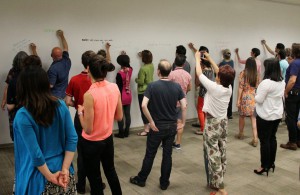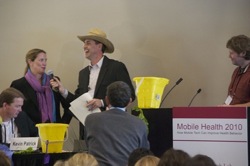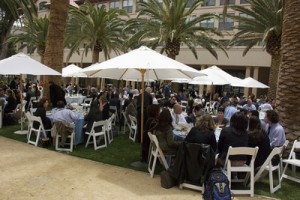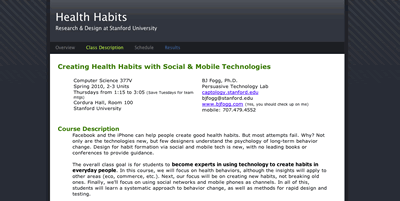The Persuasive Tech Lab creates innovative events to bring people together to share insights related to captology. Our goal is to connect people and foster collaborations in the real world.
We’ve designed the events to have a fast-pace format: 25 speakers in one day, each talking for just 12 minutes. Then we give lots of break time so people can talk.

We continued to share best practices and catalyze innovation using dance to help people lead healthier lives in 2014’s Design for Dance event.
We drew on insights from dancers, instructors, engineers, doctors, and other innovators who are all getting people to dance more. It was an event full of innovative people, moving stories, and many things to learn and do in creative, unexpected, and energizing ways.
At our Stanford lab, we believe dancing has unusual potential to promote health and happiness. But we also believe today’s options for dancing are too limited. People of all ages need new ways to bring dance into their daily lives to reap the physical, mental, and social benefits.
In 2013 we hosted the first Design for Dance event at Stanford University. Together we explored new solutions for making dance a routine activity in the lives of millions and started the “Movement” movement.

In May 2012, the Persuasive Tech Lab hosted Mobile Health 2012: Baby Steps for Big Change. We took a slightly different angle in 2012. Why? Because this method — rapid baby steps — leads to success in three areas: behavior change, collaborations, and experience design. We realized that “baby steps” is an odd focus for an entire event. But we thought it was absolutely the right focus for 2012.
The chronic problems in behavior change, collaborations, and product development have a common solution for innovators in Mobile health — and that solution is baby steps.
In 2011, the Persuasive Tech Lab and CDC hosted Mobile Health 2011: What Really Works at Stanford University. With this event we brought together 400 people from grass roots and national health organizations, academics and mobile vendors for insights and sharing best practices in what is working now to change health behaviors. We highlighted real solutions for real people — practical, proven solutions.

This sold out event hosted at Stanford had a precise and practical focus: We highlighted how today’s mobile technology can improve the health of everyday people. The emphasis was on what’s working to change behavior, right now.
The Stanford Persuasive Tech Lab hosted “Texting4Health,” the premiere conference on how mobile text messaging can promote better health in 2008. This topic matters because texting is the only viable interactive channel for reaching people on a mass scale around the world.
This expo was the final for with over 500 people attending to see demo’s of the applications. For press about this course, please see the course website. For a audio and video about the class and applications, check out this BayCHI program.
This event was the second international conference on persuasive technology. It was geared for people interested in how digital technology can motivate and influence people, a domain called captology. This includes the psychological and motivational effects of web sites, mobile phones, video games and more.
Over 260 people came to Stanford University for the first Mobile Persuasion conference in 2007. Hosted by Stanford’s Persuasive Technology Lab, this “sold out” event brought together innovators, designers, and researchers interested in mobile technologies that change people’s beliefs and behaviors.
Captology Film Festival
In 2006, the Captology Film Festival brought about 200 people together to watch 10 winning videos showing persuasive technology in action. In preparing for the event, people around the world submitted 600 ratings of 62 videos.
Please note that we no longer own the Captology.tv domain. This is an archived project and no longer available online.
Workshops
BJ Fogg and others from the lab have done too many workshops to list. Our goal is always to help people design for impact.

What people have to say about our events
“I came away feeling that I had experienced a terrific social networking and information-sharing event. Congratulations!” –Dr. Robert Gable
“You did a great job setting up the Persuasive Technology conference. I liked the fact that the sessions started right down to the minute! That’s pretty organized!”
–Jeff McCandless (NASA)
“You and your team did an amazing job. I learned a lot, met some interesting and strategically practical folks, and overall, had a great day.” –Deb Levine (ISIS)
“You did a great job on this event. It was a big success IMHO. Congratulations to you and your team.” –Don Jackson (TellMe Networks)
“Thanks for a great conference! I met some great people and overall the talks were of exceptional quality.” A.I.
“My friends and family are tired of hearing me talk about it, but Mobile Health 2010 was a great conference!” K.A.
“We loved the conference! The presentations were all really fascinating and the length of time worked really well, not to mention we made 17 extremely useful contacts that I think will either benefit our current projects or that we will collaborate with on new projects…” K.D.
“I had a blast, and thought it was the best run conference I have ever been to. It was fun, informative, and serious all at the same time – a hard balance to attain.” J.H.
“I loved the full agenda and how the information was delivered. Excellent speakers with resonating topics.” D.G.
“I thought it was a great value for the price and would attend again in a heartbeat. BJ, you
and your staff did a wonderful job.” S.Z.
“This was a fantastic gathering!! The energy and the quality of my interactions were amazing. Non stop value. Congratulations to all of you.” V.K.
“You guys were awesome and amazing. Truly, I loved it. The best I’ve ever been to. Worth every cent and I paid my own way. Full of great information….”
“The entire event felt very warm and welcoming. I left with lots of great connections and concrete plans to move projects forward. Everyone I met with was smart, engaged and really nice. It was a really rewarding time, both personally and professionally.”
“Thanks for a great conference that really maximized our time.”
“Make it happen at least once a year! Twice would be nice. Bi-coastal? I would show up quarterly because things change so fast and it is so exciting to be a part of this movement.”






 Lab Director, Dr. BJ Fogg BJ Fogg teaches at least one class a year at Stanford, usually for the
Lab Director, Dr. BJ Fogg BJ Fogg teaches at least one class a year at Stanford, usually for the